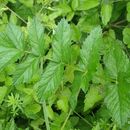Associations
(
Inglês
)
fornecido por BioImages, the virtual fieldguide, UK
Foodplant / miner
larva of Euleia heraclei mines live leaf of Pimpinella major
Foodplant / miner
larva of Phytomyza adjuncta mines leaf of Pimpinella major
Foodplant / miner
larva of Phytomyza pimpinellae mines leaf of Pimpinella major
Other: sole host/prey
In Great Britain and/or Ireland:
Foodplant / parasite
hypophyllous colony of sporangium of Plasmopara crustosa parasitises live leaf of Pimpinella major
Foodplant / parasite
telium of Puccinia pimpinellae parasitises live Pimpinella major
Foodplant / pathogen
stalked synnema of Symphyosira anamorph of Symphyosira rosea infects and damages fallen mericarp of Pimpinella major
Comprehensive Description
(
Inglês
)
fornecido por North American Flora
Pimpinella major (L,.) Huds. Fl. Angl. 110. 1762
Pimpinella Saxifraga var. major L. Sp. PI. 264. 1753.
Pimpinella magna L. Mant. 219. 1771.
Tragoselinum majus Lam. Fl. Fr. 3: 448. 1778.
Tragoselinum magnum Moench, Meth. 99. 1794.
Carum magnum Baillon, Hist. PI. 7: 178. 1879.
Selinum pimpinelloides E. H. L. Krause in Sturm, Fl. Deuts. ed. 2. 12: 55. 1904.
Perennial, glabrous to hirtellous, 3-10 dm. high; basal leaves oblong to ovate in general outline, excluding the petioles 8-20 cm. long, 4-15 cm. broad, pinnate, the leaflets 7-13, oval to oblong-lanceolate, 2-9 cm. long, 1-4 cm. broad, the terminal usually 3-cleft, all sharply serrate to incised; petioles 1-2 dm. long; cauline leaves reduced upwards with narrow sheaths; involucre wanting; involucel wanting, or of a few deciduous bractlets; rays 8-20, subequal, 3-4 cm. long; pedicels up to 5 mm. long; marginal petals somewhat radiant, white, rose, or purple; carpophore 2-cleft to the base; fruit ovoid-oblong, 2.5-3.5 mm. long, 1.5-2 mm. broad, glabrous, the ribs filiform but evident; oil-tubes usually 3 in the intervals, 4 on the commissure; seed-face
nearly plane.
Type locality: "In Europa australiore," collector unknown. Distribution: Europe; adventive in Pennsylvania.
- citação bibliográfica
- Albert Charles Smith, Mildred Esther Mathias, Lincoln Constance, Harold William Rickett. 1944-1945. UMBELLALES and CORNALES. North American flora. vol 28B. New York Botanical Garden, New York, NY
Pimpinella major
(
Inglês
)
fornecido por wikipedia EN
Pimpinella major, common name greater burnet-saxifrage[1] or hollowstem burnet saxifrage,[2] is a herbaceous perennial plant in the genus Pimpinella belonging to the carrot family (Apiaceae).
Description
Pimpinella major reaches on average 30–100 cm (10–40 in) in height. The stem is hollow, deeply grooved, mostly glabrous, and generally branched and leafy.
The leaves are dark green, slightly glossy, ovate or oblong, short-stalked, feathery, more or less deeply cut, and usually pointed. Basal leaves have a petiole 20–60 cm (8–20 in) long.
The inflorescence has a diameter of 50–60 mm (2.0–2.4 in). The flowers, usually hermaphrodite, range from white to glowing rose or soft-pink and are gathered in umbels with 11 to 16 stalks.
The flowering period extends from June to August in its native habitat. The fruits are ovoid, 2–3 mm (0.08–0.1 in) long.
Subspecies
-
Pimpinella major (L.) Huds. var. rubra Hoppe. ex Mérat
Also known as big red burnet, it is characterized by low growth and intense rose-colored petals. The stem is usually branched at the base, the branches are short and generally carry only one umbel.
-
Pimpinella major var. rosea Lindeman
-
Pimpinella major var. macrodonta (Pau) O. Bolòs & Vigo
-
Pimpinella major var. orientalis (Gouam) Fi. et Paol.
-
Pimpinella major var. dissecta (Sprengel) Fi. et Paol.
-
Pimpinella major var. bipinnata G. Beck
Distribution
Pimpinella major is widespread in central Europe and in the Caucasus and it is naturalized in North America.
Habitat
It grows in burned forests, clearings, herb-rich areas, meadows, waysides, and wooded pastures. It prefers nutrient-rich substrate and chalk and limestone soils, at an altitude of 0–2,300 m (0–7,546 ft) above sea level.
Uses
The roots of Pimpinella major have been used internally in Austrian traditional medicine - as a tisane, in milk, or in herbal liqueurs - for the treatment of disorders of the respiratory tract, fever, infections, colds, and influenza.[3]
Gallery
Close-up of flowers of P. major
Plant of Pimpinella major ssp. rubra
Figure from Deutschlands Flora in Abbildungen, 1796
P. major from a herbarium
Close-up of inflorescence of P. major
References
-
^ BSBI List 2007 (xls). Botanical Society of Britain and Ireland. Archived from the original (xls) on 2015-06-26. Retrieved 2014-10-17.
-
^ USDA, NRCS (n.d.). "Pimpinella major". The PLANTS Database (plants.usda.gov). Greensboro, North Carolina: National Plant Data Team. Retrieved 3 October 2015.
-
^ Vogl, S; Picker, P; Mihaly-Bison, J; Fakhrudin, N; Atanasov, AG; Heiss, EH; Wawrosch, C; Reznicek, G; Dirsch, VM; Saukel, J; Kopp, B (2013). "Ethnopharmacological in vitro studies on Austria's folk medicine - An unexplored lore in vitro anti-inflammatory activities of 71 Austrian traditional herbal drugs". J Ethnopharmacol. 149: 750–71. doi:10.1016/j.jep.2013.06.007. PMC 3791396. PMID 23770053.
- Pignatti S. - Flora d'Italia - Edagricole – 1982 – Vil. II, pag. 190
- Tutin, T.G. et al. - Flora Europaea, second edition - 1993

- licença
- cc-by-sa-3.0
- direitos autorais
- Wikipedia authors and editors
Pimpinella major: Brief Summary
(
Inglês
)
fornecido por wikipedia EN
Pimpinella major, common name greater burnet-saxifrage or hollowstem burnet saxifrage, is a herbaceous perennial plant in the genus Pimpinella belonging to the carrot family (Apiaceae).
- licença
- cc-by-sa-3.0
- direitos autorais
- Wikipedia authors and editors

